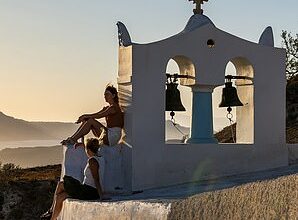Will the Seine be ready for Olympic swimming? With dry weather and a bit of luck

As an accomplished swimmer, cyclist and world-class runner, Taylor Spivey has seen worse than just the Seine in Paris.
“I’ve definitely swum in a lot more stagnant, questionable waters in my career as a professional triathlete,” the 33-year-old said The Athletics this week via email.
Spivey has swum extensively around the world over the past two decades and has become one of the nation’s top triathletes, finishing second in the sport’s 2022 Super League Championship Series and fourth in the 2022 World Triathlon Championship Series. Before taking up triathlons, she was a decorated member of multiple USA Lifesaving International teams and served as a lifeguard in Los Angeles. She will make her Olympic debut for the U.S. mixed relay team in Paris at the 2024 Summer Games this week after narrowly missing out on the 2020 Olympic roster in Tokyo.
So she spent quite a few days in rough waters.
And so the idea that the Seine might be too polluted with E. coli and other contaminants for her and the other best triathletes in the world to handle is not something she — and probably most of the other competitors — spend a lot of time thinking about. There are medals on the line. So if she and the other triathletes are allowed to do that, she’ll jump in the Seine and tackle the conditions.
“No one wants to get sick, but we also want to swim; after all, we train to swim, bike, and run,” she said in the email. “We saw this same topic of discussion in the lead-up to both the Rio (2016) and Tokyo Olympics. It’s always a concern, but it also feels like the same hype we’ve seen in the past. We swam in the Seine at the test event in Paris last yearand as far as I know no one has gotten sick from the water quality.”
Paris has centered its iconic river as a focal point for the Games. The Games’ opening ceremony on Friday will for the first time not involve nations marching through a new or renovated stadium in the host city, behind their nation’s flags. In Paris, the ceremonies will be held on the Seine, with boats carrying the more than 10,500 athletes from over 200 countries along nearly four miles of river, culminating in the city’s Trocadéro.
The city hopes that swimmers and triathletes will be able to enter the water once the boats come out of the water.
The water quality of the Seine, long one of the most famous and romanticized bodies of water in the world, where couples have strolled and occasionally danced (oh, come on: Have you never seen “An American in Paris”?), and along which so many have walked, has been a central concern for the French government as it launched the bold plan, and subsequently spent billions to support it, to make the Seine swimmable again. This, after a century of waste, human and otherwise, had left it so filthy that, with few exceptions, no one was allowed to dive in it — and 124 years since the Seine hosted swimming events at the 1900 Paris Games.
But after a $1.5 billion water storage basin opened in the city in May and several weeks of little rain in the city, the Seine’s water quality has improved significantly.
Whether the upward trend will continue in time for the Olympic and Paralympic competitions is still uncertain. The men’s and women’s triathlons are on July 30 and 31, with the mixed relay on August 5. The marathon swimming competition is scheduled for August 8 and 9. Paratriathletes will swim in the Seine on September 1 and 2.

Triathletes jumped into the Seine last August during a test of the course. American Taylor Spivey is among those who are not worried about the Seine being suitable for swimming. (Bertrand Guay/AFP via Getty Images)
Water quality standards differ in Europe from those in the United States. The beta water limit for E. coli in the US is 126 colony forming units per 100 milliliters; In Europe the limit is 900 units per 100 milliliters. The World Triathlon Federation says 900 units per 100 is safe for competition.
But if city officials find the water too dirty to swim in at the time of the events, Olympic organizers would try to move the competition dates back. If the Seine remains too dirty, the triathlon would scrap the 1,500-meter swim and become a duathlonwith only the running (10 km) and cycling (40 km) events. The marathon swimming events will be moved to the Vaires-sur-Marne Nautical Stadium, where the rowing and canoeing competitions will be held.
Like most older cities, Paris’s water supply is subject to contamination due to the mixing of rainwater and sewage in the same sewage systems. When there is little or no rain, the sewage system of a city like Paris can usually keep everything separate. But when the skies open and Paris is hit with torrential rain, the sewers overflow. Not only is sediment and garbage washed into the Seine, but so is human waste, leading to the growth of bacteria such as E. coli in the water. Such bacteria would probably not be fatal if ingested by swimmers, but they could make them very sick.
Such an event occurred a year ago when the city was hit by the worst rainfall in six decades. The water quality of the Seine deteriorated to the point that Paris had to cancel a number of test events for the marathon swimming, triathlon and paratriathlon competitions.
Yet Paris went ahead.
The vast storage basin, beneath the Austerlitz train station in the city centre, collects rainwater that would otherwise flow into the Seine. Huge tanks at the basin can hold up to 20 Olympic swimming pools’ worth of dirty water. The water is then sent through a network of underground pipes to a treatment plant downstream of the city. Once the bacteria have been removed from the water, it is returned to the city and pumped into the Seine.
Paris and its surroundings have had much drier weather this month than in spring. The drier conditions have significantly improved the quality of the Seine. But that can change in the blink of an eye.
Start of July, according to Eau de Paris, the city’s monitoring standard for the quality of the Seinetwo rainy periods, upstream of the city, “affected the water quality and flow. Despite these bad weather conditions, the water quality of the Seine reached the compliance thresholds of the European directive for 3/4 of the monitored points, for four days. At the monitoring point of the Olympic site, this level was reached six days (during the) week.”
And, making good on a long-held promise, Paris Mayor Anne Hidalgo swam in the Seine last week to emphasize that the river was clean enough for the Olympians.

Paris Mayor Anne Hidalgo took a dip in the Seine last week in the hope of allaying fears about the river. Recent tests have shown that pollutants are within regulated levels. (Victoria Valdivia/Hans Lucas/AFP via Getty Images)
“Based on what we’ve seen over the last few weeks, we’ve seen a significant improvement in water quality since about June 24 and 25,” said Dan Angelescu, Fluidion’s founder. a water monitoring company who has worked with the city for the past seven years to monitor pollution levels in the Seine at various collection points in the river.
Fluidion’s latest measurements of E. coli in the Seine, up to and including Sunday, showed that there were 591 colony-forming units per 100 milliliters in the Seine, well below the minimum of 900 units.
“So the water quality has improved,” Angelescu said. “And that can be attributed to the mild weather, the dry weather, on the one hand. And on the other hand, about a week before the date that we started seeing improvements, the Austerlitz Retention Basin, the stormwater and sewage retention tank, was first put into service and filled for the first time. So it could be that we’re seeing a combined effect of this infrastructure being operational and the weather.”
The problems Paris has with the Seine are not so different from the problems other, older cities around the world face with the rivers and streams that flow through the city.
“Where you have older infrastructure, and particularly where you have combined sewers, this is the case with older cities in the United States. This is the case with Philadelphia; this is the case with Boston, this is the case with Chicago, this is the case with New York City. The problems are the same. When you have a lot of rain, the sewers overflow, and that creates and combines flooding.”
Spivey agrees.
“The biggest concern with water quality in big cities like Los Angeles is runoff after rainfall, and only when it hasn’t rained in a while because of the buildup in storm drains,” she said. “Otherwise, especially with flowing water, I’m much less concerned when I’m on the starting line of a triathlon.”
Angelescu said it would be foolish to make predictions about what the Seine will look like on the days of the Olympics. There are too many variables, not just the weather forecast. Flooding upstream from Paris, including illegal tapping into the city’s stormwater network by homeowners and boaters, can dump significant pollutants into the Seine with little notice. Area sewage treatment plants release pollution into the river if the plants don’t disinfect their liquid waste. (Some do, but not all.)
Spivey is ready.
“I think health and safety should always be a concern, but there has to be a threshold,” Spivey said. “Athletes are determined and we are ready to take on any weather conditions, tough race courses and unexpected scenarios that come our way. The best athletes are often the most adaptable. Plus, we have trained our entire careers for this Olympic moment and to deprive athletes of the opportunity to perform in their true discipline would be a huge disappointment.”
In June, in an interview with the Canadian Broadcasting CorporationAngelescu said that given the quality of the Seine at the time, he would not feel comfortable swimming in the Seine.
Would he do that now?
“I would,” he said. “I would, actually. What I said is that the data will tell. That was my answer. And I still say that. The data today looks very different than it did a month ago. A month ago, we would not have had a single day where the water quality was acceptable all year. Look at our data from the past week. You see, with the exception of last weekend, where it was (affected by) a rain shower, the water quality is acceptable, or close to acceptable, by global triathlon standards on many days. So it’s a big difference.
“It’s a little bit ironic that it’s all at the last minute. But it’s true. We have dates. Right now, probably today, I would go swimming.”

GO DEEPER
Team USA owns the Olympic pool. Will that change in Paris?
(Top image: Dan Goldfarb/The Athletic; photo: Sina Schuldt/picture alliance via Getty Images)




